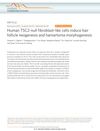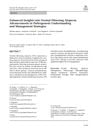Fibrous Papule of the Face, Similar to Tuberous Sclerosis Complex-Associated Angiofibroma, Shows Activation of the Mammalian Target of Rapamycin Pathway: Evidence for a Novel Therapeutic Strategy?
February 2014
in “
PLoS ONE
”
TLDR Topical rapamycin may effectively treat fibrous papules on the face.
The study investigated the activation of the mammalian target of rapamycin (mTOR) pathway in fibrous papules of the face, which are similar in appearance to tuberous sclerosis complex (TSC)-associated angiofibromas. Researchers found that phosphorylated mTOR effectors, such as p-mTOR, p-p70S6K, and p-S6, were highly expressed in fibrous papules and TSC-associated angiofibromas, but not in normal skin. This suggested that the mTOR pathway was activated in fibrous papules, similar to TSC-associated angiofibromas. The findings indicated that topical rapamycin, an mTOR inhibitor effective in treating TSC-associated angiofibromas, could be a novel therapeutic strategy for fibrous papules.



